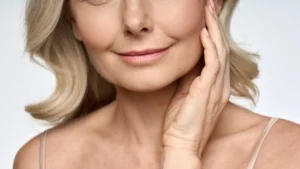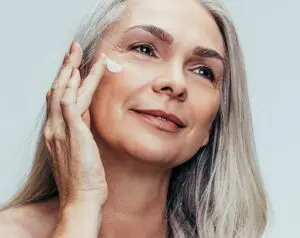As women enter the phase of menopause, they often find themselves facing a multitude of changes, both internally and externally. One common and sometimes bothersome symptom is the onset of a red or flushed face, often accompanied by heat sensations. This phenomenon, often referred to as “menopausal red face,” can be attributed to hormonal fluctuations and changes in blood flow. While it’s a common symptom, the good news is that various treatments and lifestyle adjustments can help manage and alleviate this issue. In this blog, we’ll explore effective menopause red face treatments and restore comfort to your complexion.
Contents
Does Menopause Cause Red Face?
 Yes, menopause can be associated with a red or flushed face. The hormonal changes that occur during menopause can affect blood vessels and circulation, leading to a range of skin-related symptoms, including facial redness. The primary hormone involved in menopause is estrogen, and its decline can contribute to various skin changes.
Yes, menopause can be associated with a red or flushed face. The hormonal changes that occur during menopause can affect blood vessels and circulation, leading to a range of skin-related symptoms, including facial redness. The primary hormone involved in menopause is estrogen, and its decline can contribute to various skin changes.
During menopause, estrogen levels drop significantly, impacting the blood vessels’ ability to constrict and dilate properly. This can result in increased blood flow to the skin, leading to redness and flushing. Additionally, changes in collagen and elastin, proteins that provide structure and elasticity to the skin, may contribute to the appearance of redness.
While facial redness is a common symptom, it’s important to note that individual experiences can vary. Some women may not experience significant changes in their skin during menopause, while others may notice more pronounced effects. If facial redness is a concern, it’s advisable to consult with a healthcare professional or dermatologist who can provide personalized advice and recommend appropriate treatments or skincare routines.
How Do I Get Rid Of Menopause Red Face?
Managing and reducing menopausal red face involves a combination of lifestyle changes, skincare practices, and, in some cases, medical interventions. Here are some strategies that may help alleviate menopausal red face:
Skincare Routine
- Use a gentle cleanser suitable for sensitive skin to avoid irritation.
- Choose skincare products with soothing ingredients like chamomile, aloe vera, and green tea.
- Incorporate a fragrance-free moisturizer to keep your skin hydrated.
Sun Protection
- Apply a broad-spectrum sunscreen with at least SPF 30 every morning, even on cloudy days.
- Wear a wide-brimmed hat and sunglasses when exposed to sunlight.
Diet and Nutrition
- Include anti-inflammatory foods in your diet, such as fruits, vegetables, and omega-3 fatty acids found in fish.
- Stay hydrated by drinking an adequate amount of water throughout the day.
- Consider supplements like vitamins C and E, which may support skin health.
Lifestyle Changes
- Manage stress through practices like meditation, deep breathing exercises, or yoga.
- Avoid triggers that can cause flushing, such as hot and spicy foods, alcohol, and caffeine.
- Maintain a cool environment, using fans or air conditioning if needed.
Makeup Techniques
- Use color-correcting makeup to neutralize redness.
- Choose foundations with a yellow or green undertone to balance out red tones.
- Look for long-wearing and non-comedogenic makeup products.
Regular Exercise
- Engage in regular physical activity to improve overall health and circulation.
- Opt for activities that promote relaxation, such as walking, swimming, or yoga.
Remember, individual responses to these strategies can vary, and it may take time to find the combination that works best for you. It’s advisable to consult with a healthcare professional or dermatologist to develop a personalized plan tailored to your specific needs and concerns.
What Are Some Menopause Red Face Treatments?
 There are several treatments available to help manage and reduce menopausal red face. Keep in mind that individual responses may vary, and it’s essential to consult with a healthcare professional or dermatologist for personalized advice. Here are some common menopause red face treatments:
There are several treatments available to help manage and reduce menopausal red face. Keep in mind that individual responses may vary, and it’s essential to consult with a healthcare professional or dermatologist for personalized advice. Here are some common menopause red face treatments:
Hormone Replacement Therapy (HRT)
Hormone Replacement Therapy (HRT) is a medical intervention that involves supplementing the body with hormones, such as estrogen or a combination of estrogen and progesterone, to address the hormonal imbalances associated with menopause. By replenishing these hormones, HRT can alleviate various menopausal symptoms, including facial redness. However, it’s essential to consult with a healthcare provider to discuss the potential benefits and risks of HRT, as it may not be suitable for everyone and is associated with certain health considerations.
Prescription Topical Medications
Prescription topical medications can be effective in reducing menopausal red face. These may include creams or gels containing metronidazole or azelaic acid, which have anti-inflammatory properties. These medications work by helping to control blood vessel dilation and reduce redness. It’s crucial to follow the prescribed regimen and be aware of any potential side effects, such as irritation or dryness, which should be communicated to the healthcare provider.
Oral Medications
Oral medications prescribed for menopausal red face may include antibiotics with anti-inflammatory effects or medications targeting blood vessel dilation. These medications can help manage the underlying causes of facial redness. As with any medication, it’s important to discuss potential side effects, interactions, and the overall suitability of the treatment with a healthcare professional.
Laser Therapy
Laser treatments, such as pulsed dye lasers and intense pulsed light (IPL), are non-invasive procedures that target blood vessels, reducing redness associated with menopause. These treatments work by delivering controlled light energy to the skin, promoting collagen production, and reducing the appearance of blood vessels. Multiple sessions may be required for optimal results, and a dermatologist can guide the most suitable laser therapy based on individual needs.
Cooling and Soothing Skincare Products
Incorporating cooling and soothing skincare products into your routine can provide relief for menopausal red face. Products with ingredients like chamomile, aloe vera, and green tea have anti-inflammatory and calming properties. A gentle cleanser and fragrance-free moisturizer can help maintain skin health without irritating. Avoiding harsh chemicals and fragrances is essential to prevent exacerbating redness.
Anti-Inflammatory Diet
Adopting an anti-inflammatory diet can contribute to managing menopausal red face from the inside out. Include foods rich in antioxidants, such as fruits, and vegetables, and foods containing omega-3 fatty acids like fatty fish. These nutrients can help combat inflammation and support overall skin health. Staying well-hydrated by drinking an adequate amount of water also contributes to maintaining skin hydration and may alleviate some menopausal skin symptoms.
Stress Management
Stress is a common trigger for facial redness, and effective stress management can play a significant role in managing this symptom. Practices such as meditation, deep breathing exercises, and yoga can help reduce stress levels. Finding activities that promote relaxation and incorporating them into a daily routine can have positive effects not only on facial redness but also on overall well-being. Identifying and addressing sources of stress in one’s life is crucial for long-term management.
It’s crucial to work closely with a healthcare professional to determine the most appropriate treatment plan based on your specific symptoms and medical history. They can guide you in selecting treatments that are safe and effective for managing menopausal red face.
How Can I Prevent Menopause Red Face?
 Preventing menopausal red face involves a proactive approach to skincare, lifestyle, and overall well-being. Here are additional strategies to help prevent and minimize menopausal redness:
Preventing menopausal red face involves a proactive approach to skincare, lifestyle, and overall well-being. Here are additional strategies to help prevent and minimize menopausal redness:
- Hydrate from Within
Drinking an ample amount of water helps maintain skin hydration and can contribute to preventing skin redness. Aim for at least eight glasses of water per day, and consider incorporating hydrating foods into your diet, such as water-rich fruits and vegetables.
- Avoid Hot Baths and Showers
Hot water can exacerbate facial redness. Opt for lukewarm water when washing your face and avoid prolonged hot baths or showers. Extreme temperatures can dilate blood vessels, leading to increased redness and irritation.
- Choose Gentle Fabrics
When selecting clothing, opt for soft, breathable fabrics like cotton. Avoid materials that may cause friction and irritation, as this can contribute to facial redness.
- Cooling Face Mists
Keep a cooling facial mist on hand to provide instant relief. Look for mists containing ingredients like cucumber or rosewater. This can soothe and refresh the skin, reducing redness.
- Monitor Triggers
Pay attention to factors that trigger facial redness and try to minimize exposure. Common triggers may include spicy foods, hot beverages, or alcohol. Identifying and avoiding these triggers can help prevent redness from intensifying.
- Adequate Sleep
Ensure you get enough quality sleep each night. Lack of sleep can contribute to stress and hormonal imbalances, potentially leading to increased facial redness. Establish a consistent sleep routine and create a relaxing bedtime environment.
- Mindful Breathing Exercises
Incorporate mindfulness and deep breathing exercises into your daily routine. Mindful breathing can help reduce stress levels, promoting a sense of calm that can positively impact your skin’s appearance.
- Regular Dermatological Check-ups
Schedule regular check-ups with a dermatologist to monitor your skin’s health. A dermatologist can provide personalized advice and address any emerging concerns related to menopausal skin changes.
By incorporating these additional strategies into your daily routine, you can take a proactive approach to prevent and manage menopausal red face. It’s important to listen to your body, make adjustments as needed, and seek professional guidance when necessary.
Conclusion
In conclusion, menopause red face treatments involve a holistic approach that combines skincare, lifestyle adjustments, and self-care practices. From adopting a gentle skincare routine and incorporating soothing ingredients to making healthy lifestyle choices such as staying hydrated, protecting against sun exposure, and managing stress, there are various strategies to explore. Additionally, medical interventions can be considered with guidance from healthcare professionals.
Remember, every woman’s experience is unique, so finding a personalized combination of these strategies is key. With patience, experimentation, and the right information, it’s possible to navigate the challenges of menopausal red face and embrace this new phase of life with confidence and comfort. If you are facing menopause-related issues, menopause treatment at HerMantra can help. Book your free trial online menopause treatment session now.


